University Report: Financial Crisis and Great Depression Analysis
VerifiedAdded on 2023/05/30
|7
|1462
|453
Report
AI Summary
This report provides a comprehensive overview of the Financial Crisis and Great Depression up to 1929, examining the economic conditions and factors that led to the crisis. It delves into the perspectives of economists such as Mishkin, exploring the roles of financial institutions, stock market crashes, and bank panics. The report also analyzes the causes and effects of the crisis, including the impact of debt deflation and the sequence of events leading to the financial downturn. Additionally, the report discusses the subprime crisis and financial innovation in mortgage markets. Figures and diagrams are used to illustrate the sequence of financial crises and the stages involved. The report also includes a discussion on triggers such as mismanagement of financial liberalization, fiscal imbalances, and increases in interest rates. The report is a valuable resource for understanding the complexities of financial crises. This assignment is contributed by a student to be published on the website Desklib. Desklib is a platform which provides all the necessary AI based study tools for students.
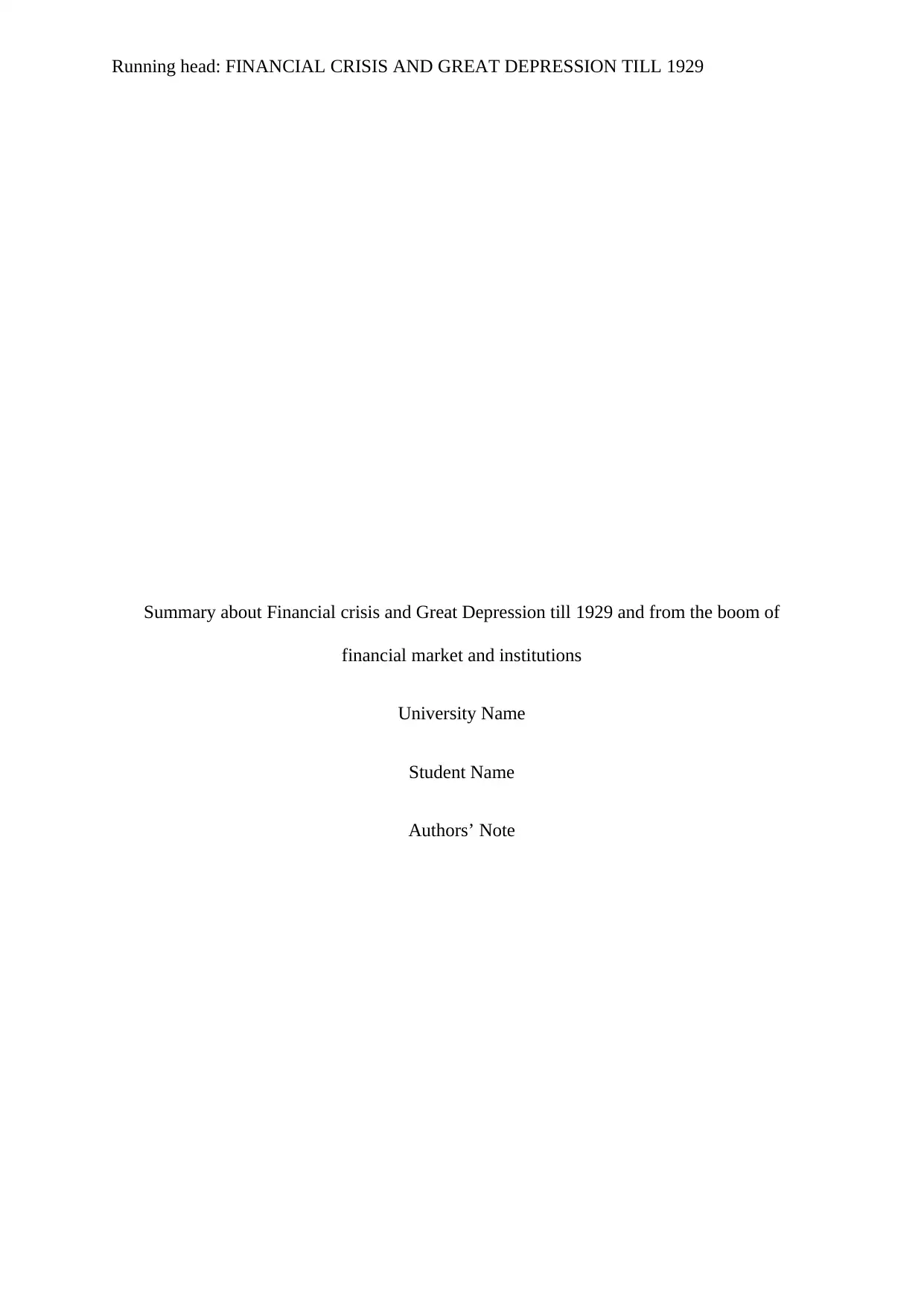
Running head: FINANCIAL CRISIS AND GREAT DEPRESSION TILL 1929
Summary about Financial crisis and Great Depression till 1929 and from the boom of
financial market and institutions
University Name
Student Name
Authors’ Note
Summary about Financial crisis and Great Depression till 1929 and from the boom of
financial market and institutions
University Name
Student Name
Authors’ Note
Paraphrase This Document
Need a fresh take? Get an instant paraphrase of this document with our AI Paraphraser
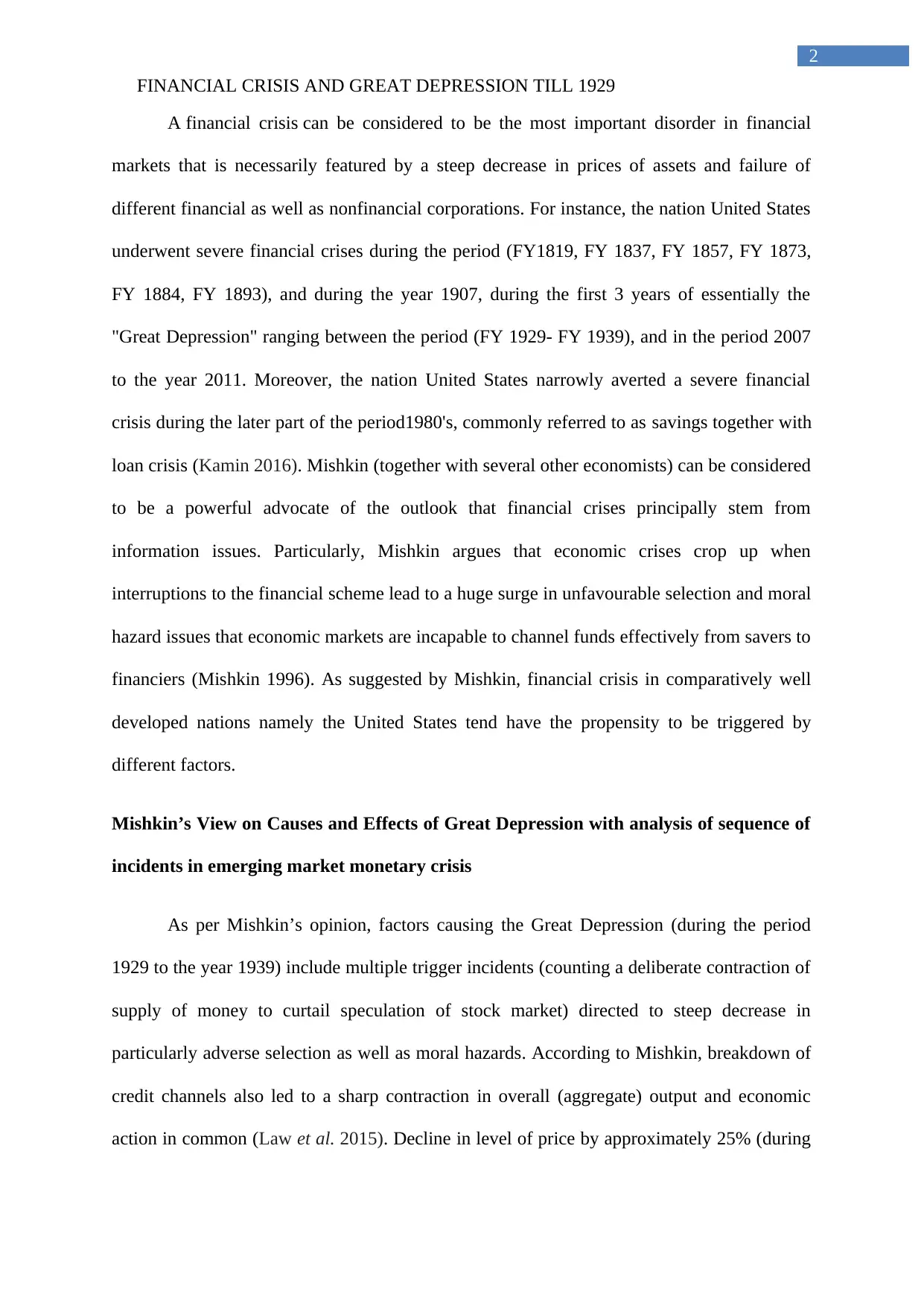
2
FINANCIAL CRISIS AND GREAT DEPRESSION TILL 1929
A financial crisis can be considered to be the most important disorder in financial
markets that is necessarily featured by a steep decrease in prices of assets and failure of
different financial as well as nonfinancial corporations. For instance, the nation United States
underwent severe financial crises during the period (FY1819, FY 1837, FY 1857, FY 1873,
FY 1884, FY 1893), and during the year 1907, during the first 3 years of essentially the
"Great Depression" ranging between the period (FY 1929- FY 1939), and in the period 2007
to the year 2011. Moreover, the nation United States narrowly averted a severe financial
crisis during the later part of the period1980's, commonly referred to as savings together with
loan crisis (Kamin 2016). Mishkin (together with several other economists) can be considered
to be a powerful advocate of the outlook that financial crises principally stem from
information issues. Particularly, Mishkin argues that economic crises crop up when
interruptions to the financial scheme lead to a huge surge in unfavourable selection and moral
hazard issues that economic markets are incapable to channel funds effectively from savers to
financiers (Mishkin 1996). As suggested by Mishkin, financial crisis in comparatively well
developed nations namely the United States tend have the propensity to be triggered by
different factors.
Mishkin’s View on Causes and Effects of Great Depression with analysis of sequence of
incidents in emerging market monetary crisis
As per Mishkin’s opinion, factors causing the Great Depression (during the period
1929 to the year 1939) include multiple trigger incidents (counting a deliberate contraction of
supply of money to curtail speculation of stock market) directed to steep decrease in
particularly adverse selection as well as moral hazards. According to Mishkin, breakdown of
credit channels also led to a sharp contraction in overall (aggregate) output and economic
action in common (Law et al. 2015). Decline in level of price by approximately 25% (during
FINANCIAL CRISIS AND GREAT DEPRESSION TILL 1929
A financial crisis can be considered to be the most important disorder in financial
markets that is necessarily featured by a steep decrease in prices of assets and failure of
different financial as well as nonfinancial corporations. For instance, the nation United States
underwent severe financial crises during the period (FY1819, FY 1837, FY 1857, FY 1873,
FY 1884, FY 1893), and during the year 1907, during the first 3 years of essentially the
"Great Depression" ranging between the period (FY 1929- FY 1939), and in the period 2007
to the year 2011. Moreover, the nation United States narrowly averted a severe financial
crisis during the later part of the period1980's, commonly referred to as savings together with
loan crisis (Kamin 2016). Mishkin (together with several other economists) can be considered
to be a powerful advocate of the outlook that financial crises principally stem from
information issues. Particularly, Mishkin argues that economic crises crop up when
interruptions to the financial scheme lead to a huge surge in unfavourable selection and moral
hazard issues that economic markets are incapable to channel funds effectively from savers to
financiers (Mishkin 1996). As suggested by Mishkin, financial crisis in comparatively well
developed nations namely the United States tend have the propensity to be triggered by
different factors.
Mishkin’s View on Causes and Effects of Great Depression with analysis of sequence of
incidents in emerging market monetary crisis
As per Mishkin’s opinion, factors causing the Great Depression (during the period
1929 to the year 1939) include multiple trigger incidents (counting a deliberate contraction of
supply of money to curtail speculation of stock market) directed to steep decrease in
particularly adverse selection as well as moral hazards. According to Mishkin, breakdown of
credit channels also led to a sharp contraction in overall (aggregate) output and economic
action in common (Law et al. 2015). Decline in level of price by approximately 25% (during
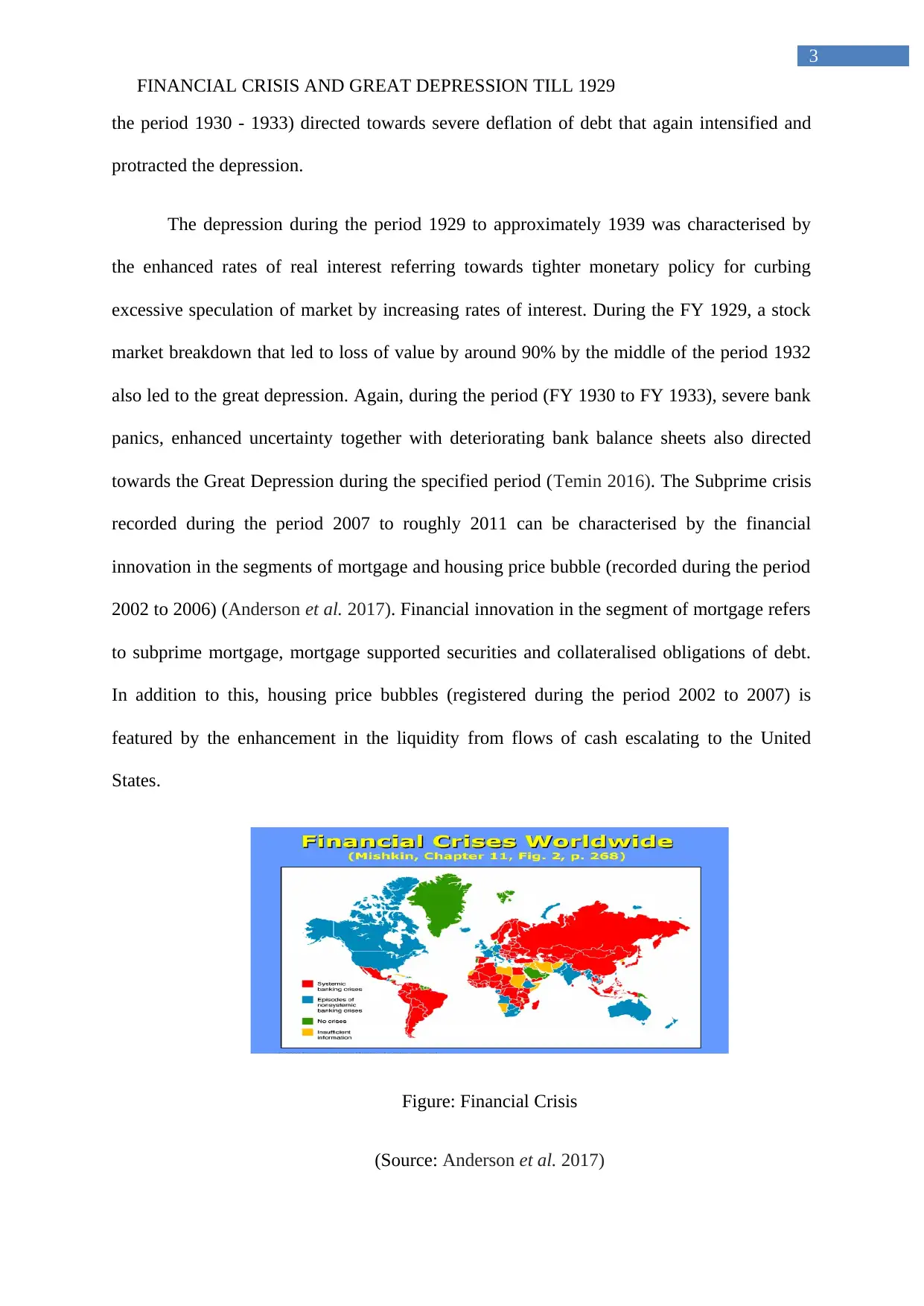
3
FINANCIAL CRISIS AND GREAT DEPRESSION TILL 1929
the period 1930 - 1933) directed towards severe deflation of debt that again intensified and
protracted the depression.
The depression during the period 1929 to approximately 1939 was characterised by
the enhanced rates of real interest referring towards tighter monetary policy for curbing
excessive speculation of market by increasing rates of interest. During the FY 1929, a stock
market breakdown that led to loss of value by around 90% by the middle of the period 1932
also led to the great depression. Again, during the period (FY 1930 to FY 1933), severe bank
panics, enhanced uncertainty together with deteriorating bank balance sheets also directed
towards the Great Depression during the specified period (Temin 2016). The Subprime crisis
recorded during the period 2007 to roughly 2011 can be characterised by the financial
innovation in the segments of mortgage and housing price bubble (recorded during the period
2002 to 2006) (Anderson et al. 2017). Financial innovation in the segment of mortgage refers
to subprime mortgage, mortgage supported securities and collateralised obligations of debt.
In addition to this, housing price bubbles (registered during the period 2002 to 2007) is
featured by the enhancement in the liquidity from flows of cash escalating to the United
States.
Figure: Financial Crisis
(Source: Anderson et al. 2017)
FINANCIAL CRISIS AND GREAT DEPRESSION TILL 1929
the period 1930 - 1933) directed towards severe deflation of debt that again intensified and
protracted the depression.
The depression during the period 1929 to approximately 1939 was characterised by
the enhanced rates of real interest referring towards tighter monetary policy for curbing
excessive speculation of market by increasing rates of interest. During the FY 1929, a stock
market breakdown that led to loss of value by around 90% by the middle of the period 1932
also led to the great depression. Again, during the period (FY 1930 to FY 1933), severe bank
panics, enhanced uncertainty together with deteriorating bank balance sheets also directed
towards the Great Depression during the specified period (Temin 2016). The Subprime crisis
recorded during the period 2007 to roughly 2011 can be characterised by the financial
innovation in the segments of mortgage and housing price bubble (recorded during the period
2002 to 2006) (Anderson et al. 2017). Financial innovation in the segment of mortgage refers
to subprime mortgage, mortgage supported securities and collateralised obligations of debt.
In addition to this, housing price bubbles (registered during the period 2002 to 2007) is
featured by the enhancement in the liquidity from flows of cash escalating to the United
States.
Figure: Financial Crisis
(Source: Anderson et al. 2017)
⊘ This is a preview!⊘
Do you want full access?
Subscribe today to unlock all pages.

Trusted by 1+ million students worldwide
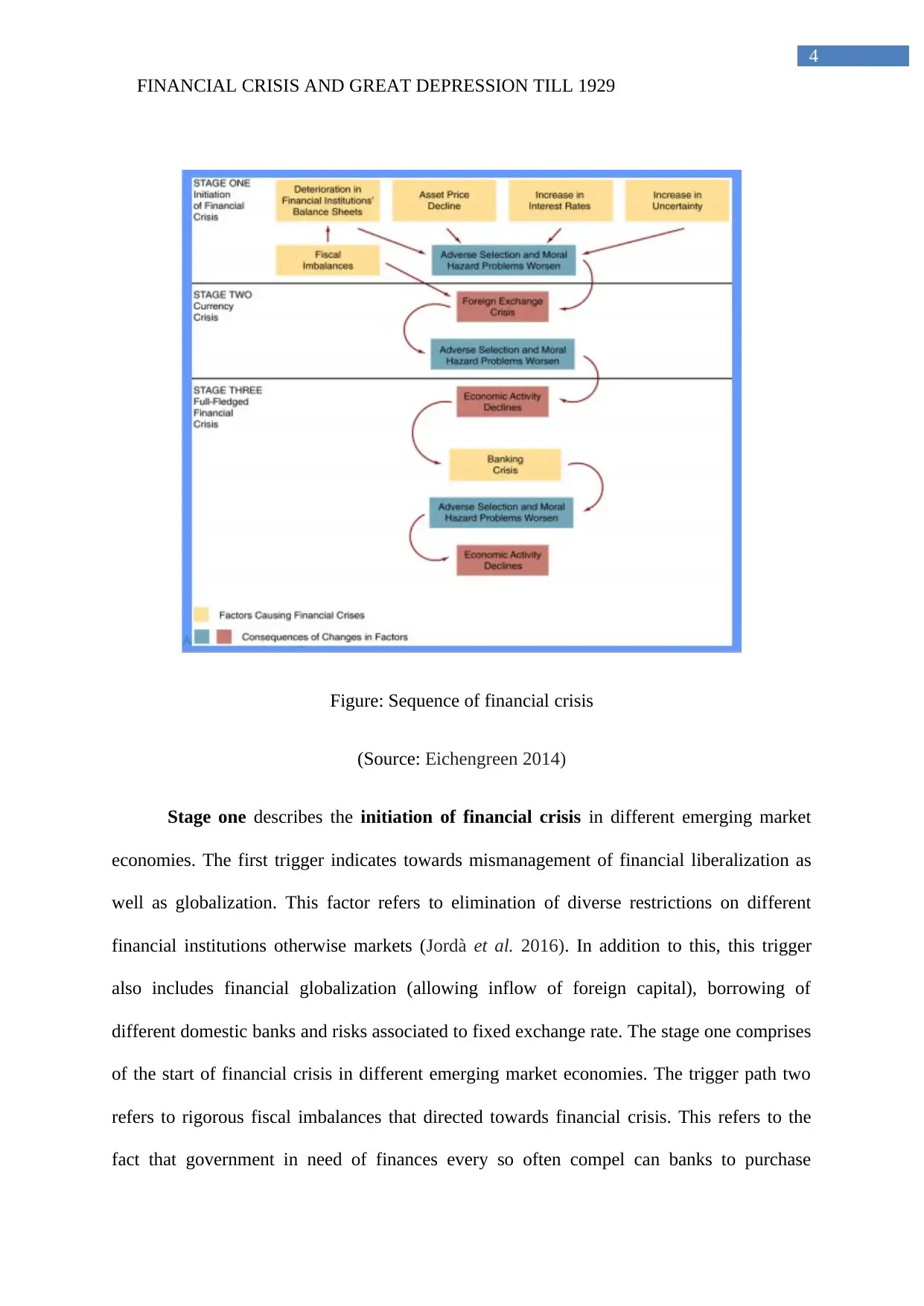
4
FINANCIAL CRISIS AND GREAT DEPRESSION TILL 1929
Figure: Sequence of financial crisis
(Source: Eichengreen 2014)
Stage one describes the initiation of financial crisis in different emerging market
economies. The first trigger indicates towards mismanagement of financial liberalization as
well as globalization. This factor refers to elimination of diverse restrictions on different
financial institutions otherwise markets (Jordà et al. 2016). In addition to this, this trigger
also includes financial globalization (allowing inflow of foreign capital), borrowing of
different domestic banks and risks associated to fixed exchange rate. The stage one comprises
of the start of financial crisis in different emerging market economies. The trigger path two
refers to rigorous fiscal imbalances that directed towards financial crisis. This refers to the
fact that government in need of finances every so often compel can banks to purchase
FINANCIAL CRISIS AND GREAT DEPRESSION TILL 1929
Figure: Sequence of financial crisis
(Source: Eichengreen 2014)
Stage one describes the initiation of financial crisis in different emerging market
economies. The first trigger indicates towards mismanagement of financial liberalization as
well as globalization. This factor refers to elimination of diverse restrictions on different
financial institutions otherwise markets (Jordà et al. 2016). In addition to this, this trigger
also includes financial globalization (allowing inflow of foreign capital), borrowing of
different domestic banks and risks associated to fixed exchange rate. The stage one comprises
of the start of financial crisis in different emerging market economies. The trigger path two
refers to rigorous fiscal imbalances that directed towards financial crisis. This refers to the
fact that government in need of finances every so often compel can banks to purchase
Paraphrase This Document
Need a fresh take? Get an instant paraphrase of this document with our AI Paraphraser
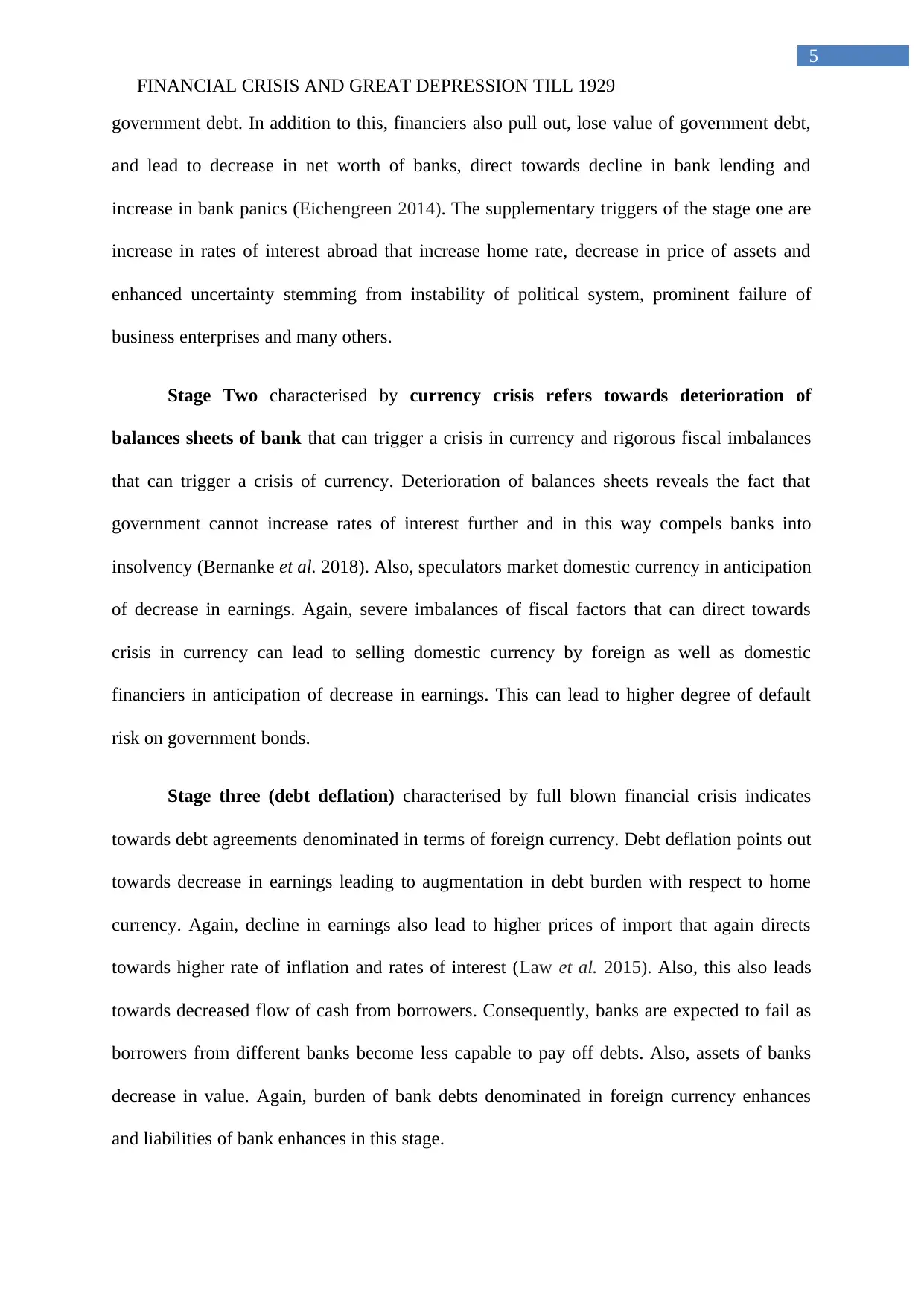
5
FINANCIAL CRISIS AND GREAT DEPRESSION TILL 1929
government debt. In addition to this, financiers also pull out, lose value of government debt,
and lead to decrease in net worth of banks, direct towards decline in bank lending and
increase in bank panics (Eichengreen 2014). The supplementary triggers of the stage one are
increase in rates of interest abroad that increase home rate, decrease in price of assets and
enhanced uncertainty stemming from instability of political system, prominent failure of
business enterprises and many others.
Stage Two characterised by currency crisis refers towards deterioration of
balances sheets of bank that can trigger a crisis in currency and rigorous fiscal imbalances
that can trigger a crisis of currency. Deterioration of balances sheets reveals the fact that
government cannot increase rates of interest further and in this way compels banks into
insolvency (Bernanke et al. 2018). Also, speculators market domestic currency in anticipation
of decrease in earnings. Again, severe imbalances of fiscal factors that can direct towards
crisis in currency can lead to selling domestic currency by foreign as well as domestic
financiers in anticipation of decrease in earnings. This can lead to higher degree of default
risk on government bonds.
Stage three (debt deflation) characterised by full blown financial crisis indicates
towards debt agreements denominated in terms of foreign currency. Debt deflation points out
towards decrease in earnings leading to augmentation in debt burden with respect to home
currency. Again, decline in earnings also lead to higher prices of import that again directs
towards higher rate of inflation and rates of interest (Law et al. 2015). Also, this also leads
towards decreased flow of cash from borrowers. Consequently, banks are expected to fail as
borrowers from different banks become less capable to pay off debts. Also, assets of banks
decrease in value. Again, burden of bank debts denominated in foreign currency enhances
and liabilities of bank enhances in this stage.
FINANCIAL CRISIS AND GREAT DEPRESSION TILL 1929
government debt. In addition to this, financiers also pull out, lose value of government debt,
and lead to decrease in net worth of banks, direct towards decline in bank lending and
increase in bank panics (Eichengreen 2014). The supplementary triggers of the stage one are
increase in rates of interest abroad that increase home rate, decrease in price of assets and
enhanced uncertainty stemming from instability of political system, prominent failure of
business enterprises and many others.
Stage Two characterised by currency crisis refers towards deterioration of
balances sheets of bank that can trigger a crisis in currency and rigorous fiscal imbalances
that can trigger a crisis of currency. Deterioration of balances sheets reveals the fact that
government cannot increase rates of interest further and in this way compels banks into
insolvency (Bernanke et al. 2018). Also, speculators market domestic currency in anticipation
of decrease in earnings. Again, severe imbalances of fiscal factors that can direct towards
crisis in currency can lead to selling domestic currency by foreign as well as domestic
financiers in anticipation of decrease in earnings. This can lead to higher degree of default
risk on government bonds.
Stage three (debt deflation) characterised by full blown financial crisis indicates
towards debt agreements denominated in terms of foreign currency. Debt deflation points out
towards decrease in earnings leading to augmentation in debt burden with respect to home
currency. Again, decline in earnings also lead to higher prices of import that again directs
towards higher rate of inflation and rates of interest (Law et al. 2015). Also, this also leads
towards decreased flow of cash from borrowers. Consequently, banks are expected to fail as
borrowers from different banks become less capable to pay off debts. Also, assets of banks
decrease in value. Again, burden of bank debts denominated in foreign currency enhances
and liabilities of bank enhances in this stage.
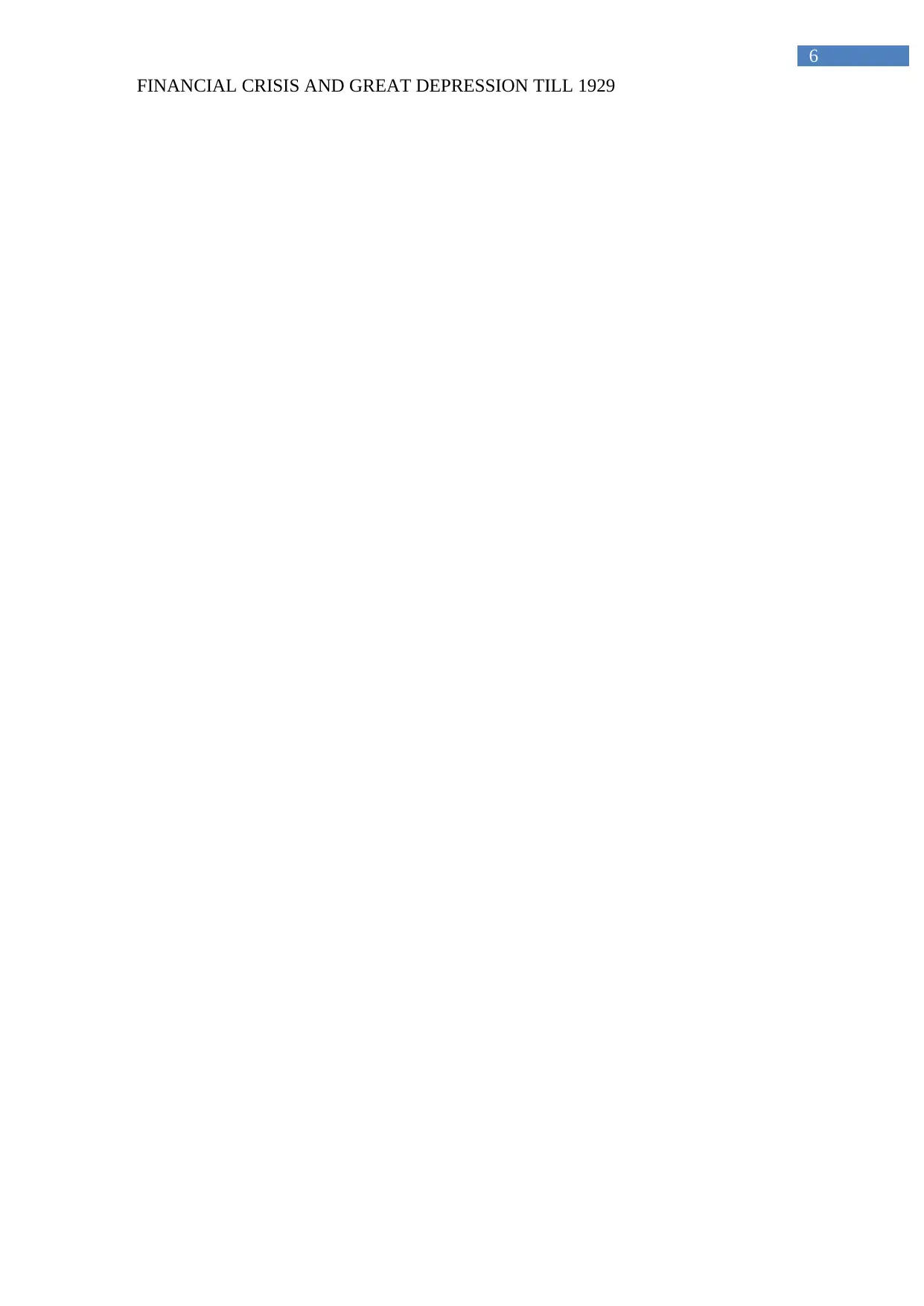
6
FINANCIAL CRISIS AND GREAT DEPRESSION TILL 1929
FINANCIAL CRISIS AND GREAT DEPRESSION TILL 1929
⊘ This is a preview!⊘
Do you want full access?
Subscribe today to unlock all pages.

Trusted by 1+ million students worldwide
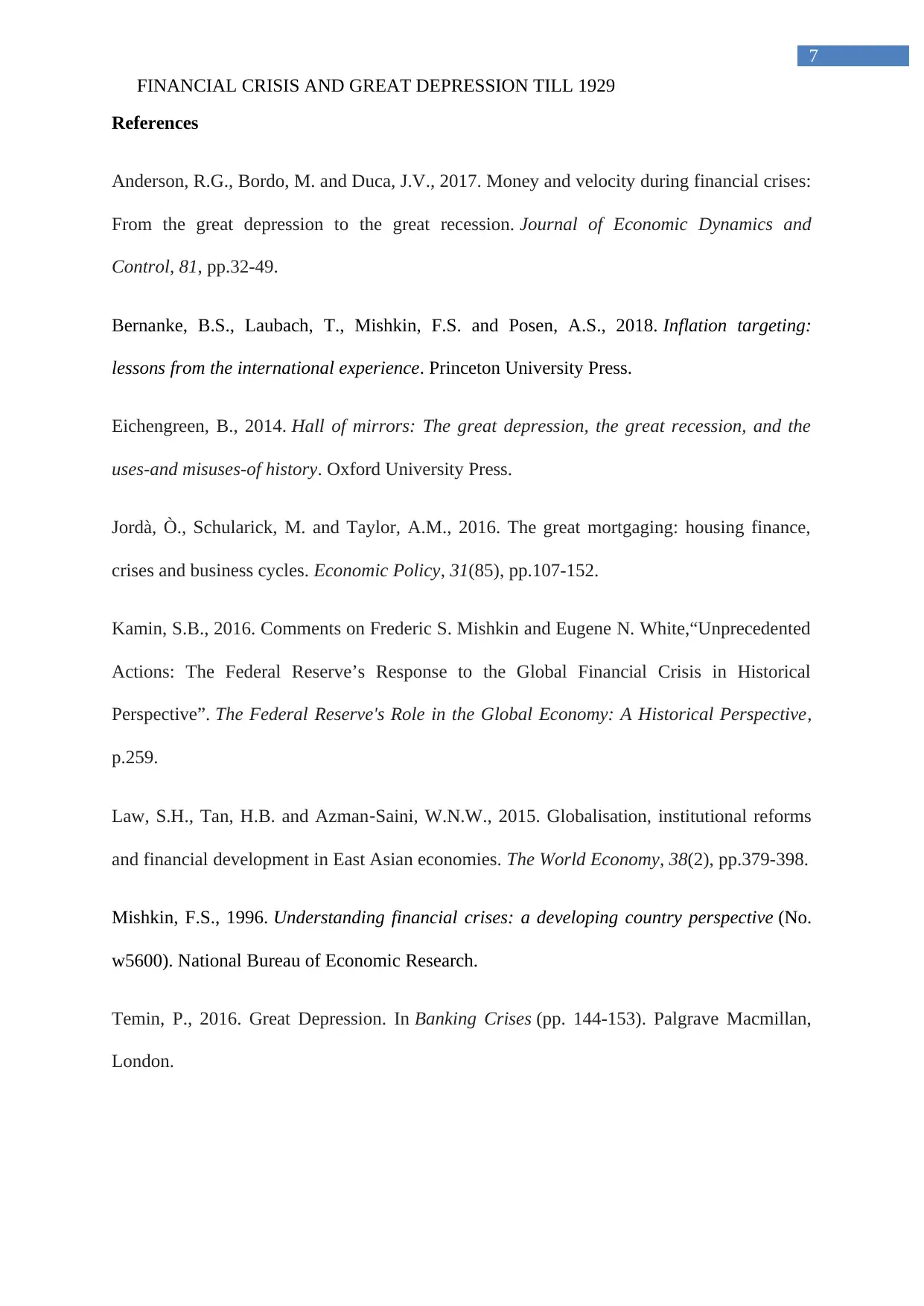
7
FINANCIAL CRISIS AND GREAT DEPRESSION TILL 1929
References
Anderson, R.G., Bordo, M. and Duca, J.V., 2017. Money and velocity during financial crises:
From the great depression to the great recession. Journal of Economic Dynamics and
Control, 81, pp.32-49.
Bernanke, B.S., Laubach, T., Mishkin, F.S. and Posen, A.S., 2018. Inflation targeting:
lessons from the international experience. Princeton University Press.
Eichengreen, B., 2014. Hall of mirrors: The great depression, the great recession, and the
uses-and misuses-of history. Oxford University Press.
Jordà, Ò., Schularick, M. and Taylor, A.M., 2016. The great mortgaging: housing finance,
crises and business cycles. Economic Policy, 31(85), pp.107-152.
Kamin, S.B., 2016. Comments on Frederic S. Mishkin and Eugene N. White,“Unprecedented
Actions: The Federal Reserve’s Response to the Global Financial Crisis in Historical
Perspective”. The Federal Reserve's Role in the Global Economy: A Historical Perspective,
p.259.
Law, S.H., Tan, H.B. and Azman‐Saini, W.N.W., 2015. Globalisation, institutional reforms
and financial development in East Asian economies. The World Economy, 38(2), pp.379-398.
Mishkin, F.S., 1996. Understanding financial crises: a developing country perspective (No.
w5600). National Bureau of Economic Research.
Temin, P., 2016. Great Depression. In Banking Crises (pp. 144-153). Palgrave Macmillan,
London.
FINANCIAL CRISIS AND GREAT DEPRESSION TILL 1929
References
Anderson, R.G., Bordo, M. and Duca, J.V., 2017. Money and velocity during financial crises:
From the great depression to the great recession. Journal of Economic Dynamics and
Control, 81, pp.32-49.
Bernanke, B.S., Laubach, T., Mishkin, F.S. and Posen, A.S., 2018. Inflation targeting:
lessons from the international experience. Princeton University Press.
Eichengreen, B., 2014. Hall of mirrors: The great depression, the great recession, and the
uses-and misuses-of history. Oxford University Press.
Jordà, Ò., Schularick, M. and Taylor, A.M., 2016. The great mortgaging: housing finance,
crises and business cycles. Economic Policy, 31(85), pp.107-152.
Kamin, S.B., 2016. Comments on Frederic S. Mishkin and Eugene N. White,“Unprecedented
Actions: The Federal Reserve’s Response to the Global Financial Crisis in Historical
Perspective”. The Federal Reserve's Role in the Global Economy: A Historical Perspective,
p.259.
Law, S.H., Tan, H.B. and Azman‐Saini, W.N.W., 2015. Globalisation, institutional reforms
and financial development in East Asian economies. The World Economy, 38(2), pp.379-398.
Mishkin, F.S., 1996. Understanding financial crises: a developing country perspective (No.
w5600). National Bureau of Economic Research.
Temin, P., 2016. Great Depression. In Banking Crises (pp. 144-153). Palgrave Macmillan,
London.
1 out of 7
Your All-in-One AI-Powered Toolkit for Academic Success.
+13062052269
info@desklib.com
Available 24*7 on WhatsApp / Email
![[object Object]](/_next/static/media/star-bottom.7253800d.svg)
Unlock your academic potential
Copyright © 2020–2026 A2Z Services. All Rights Reserved. Developed and managed by ZUCOL.


